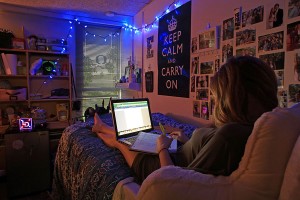Marshall alumnus creates music lighting controller
Marshall School of Business alumnus Dylan Garrett, is in the finishing stages of creating a music lighting controller called LightDance with the help of Kickstarter, a funding platform geared toward creative ideas and projects.

Bust a move · LightDance, a device created by USC alumnus Dylan Garrett, reads sound and rhythm to create real-time light shows. – Photo courtesy of Dylan Garrett
LightDance is a compact, 5-inch-by-5-inch device designed to create real-time visual reaction to music through an internal micro processing chip responsible for reading sound and rhythm to release a light show based on the music’s bass and treble components. The innovative company stemmed from Garrett’s interest in electronic music and technology in his high school and undergraduate years, during which he was on the robotics team and took various Viterbi engineering courses to supplement his major in business administration.
“During Welcome Week, I set up the system in my room at Birnkrant [Residence Hall,] and within 10 minutes, we had 25 people and an impromptu dance party,” Garrett said. “Here I was, putting these things together on my floor using a soldering iron with parts I ripped from other products off Ali Baba and Amazon, and it shaped my USC experience from there.”
According to Garrett, the USC Entrepreneurship program is very focused on “idea discovery,” and with the advice and assistance of several key professors, including Associate Professor of Clinical Management Communication Stacy Geck and Marshall Adjunct Professor Lori Williams, he was able to clearly shape and define a business, marketing and financial plan and process for LightDance.
“Garrett took my feasibility course based entirely on taking your own concept from beginning to end,” Williams said. “The first is the business concept itself, and then there is an aspect of customer assessment, marketing communications, supply chain distribution and, finally, financial analysis.”
According to Williams, the concept is a fascinating one and can be applied to a variety of situations and customers. It can be sold to D.J.’s and utilized at parties, and it has also now been streamlined into something the regular consumer can use. This newfound flexibility of LightDance simply adds to its potential success.
“Dylan and his dad, who is president of LightDance, came to my office last year and asked me what I thought of the product before setting my office to be aglow,” Geck said. “It was awesome. We talked about the various age groups, who he could target this to and how to brand the concept for specific markets.”
Garrett performed extensive research on the technical aspects of the product and proactively pitched the concept to potential buyers and those interested in the music lightshow concept. He noticed how expensive and complicated typical D.J. lighting systems are and was motivated to create something simple yet versatile. The set-up process for the LightDance controller is straightforward — one only has to plug in a light source, music source and speaker system. Based on the bass and treble intensity of a specific music selection, the device reacts to the beat and dims, flashing and changing the colors of the lights around the venue.
According to LightDance’s Chief Technology Officer Craig Godwin, the controller’s computing power is greater than the capacity of early home desktop computers. There are standard electrical outlets on the side of the box with circuitry that maxes out at approximately 600 watts — enough power for professional ProCan lighting and line voltage lights, whereas other products are often only capable of turning out LED low-voltage lighting.
The Kickstarter site offers various incentives for people who pledge funding to the project. Starting at $129, donors can get the LightDance device for a discount and higher donations receive packs which include anything from one LightDance controller to a controller with two rope lights or the “DJ Pack” which features two stage lights and color gels with the controller. Following the end of the Kickstarter Campaign, Light Dance LLC plans to begin shipping out the product via its Kickstarter site and eventually through bigger retailer platforms such Amazon, Guitar Center, Target and Best Buy. Until then, Garrett and his team will continue tweaking design and technical components before shipping LightDance off to product manufacturers for sale in the United States.
“You can really use any type of lighting, especially Christmas lights this time of year are very cheap, or you can even plug in a desk lamp,” Godwin said. “My kids will plug in their X-Box and a floor lamp to the [LightDance], and every time there’s an explosion, the whole room lights up.”

